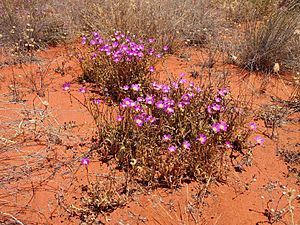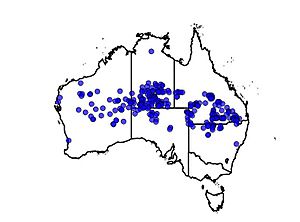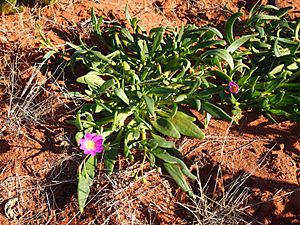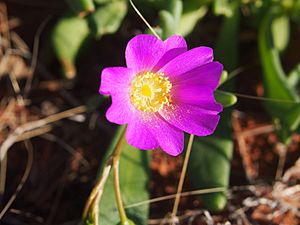Calandrinia balonensis facts for kids
Quick facts for kids Calandrinia balonensis |
|
|---|---|
 |
|
| Scientific classification | |
| Genus: |
Calandrinia
|
| Species: |
balonensis
|
 |
|
| Occurrence data from AVH | |
Calandrinia balonensis is a special type of plant called a succulent. This means it has thick, fleshy parts that store water. It grows naturally in the dry and semi-dry areas of Australia.
Its scientific name comes from Jean-Louis Calandrini, a professor who studied plants a long time ago. The "balonensis" part refers to the Balonne River in Queensland. This is where the first plant of its kind was found. People also call C. balonensis by other names like parakeelya or broad-leaf parakeelya. The name "parakeelya" comes from one of the many names Aboriginal Australian people use for this plant. You might even find C. balonensis sold as a garden plant under the name Calandrinia ‘Mystique’.
Contents
What Does It Look Like?
C. balonensis is an annual herb, which means it lives for about one year. It has bright green leaves and spreads out up to 60 cm wide. Its flower stems can grow up to 30 cm tall.
The leaves are thick and fleshy. They are usually 5 to 20 mm wide and 20 to 100 mm long. Each leaf has a small groove along its top. Even though they look flat from above, you can see how thick they are when you turn them over. The leaves grow in a circle at the bottom of the plant. They also grow up the flower stems.
Each stem has three or four flowers at the top. The flowers are a bright dark pink or purple color. They have five petals that are about 11 to 15 mm long. In the middle, they have bright yellow parts called stamens. These flowers open during the day and close when the sun goes down. After the flowers, small capsules grow. These capsules are like tiny seed pods. They are 5 to 9 mm long and hold many dark-red seeds. Each seed is at least 1 mm across.
Plant Family and Names
C. balonensis is one of about 74 Calandrinia species that grow in Australia. Calandrinia plants are some of the most common succulents in Australia. They are related to the pigweeds (Portulaca species).
Scientists have discussed whether Australian Calandrinia plants are closely related to Calandrinia plants found in the Americas. Some studies suggest they might not be as closely related as once thought. There is also a discussion about changing the name of the Australian Calandrinia plants. One idea is to rename them Parakeelya. This name is already used by Aboriginal people for these plants. It is also a common name for the whole group of plants.
Where Does It Grow?
You can find C. balonensis in many dry and semi-dry parts of Australia. It grows in New South Wales, the Northern Territory, Queensland, South Australia, and Western Australia.
It likes to grow on sandy plains, sand dunes, and along sandy riverbeds that sometimes have water. You might also find it on gravelly hills. This plant often grows near mulga trees and poplar box woodlands. It also grows in areas with spinifex grasses.
How It Survives in Dry Places
The special features of C. balonensis help it live in dry areas. Its most important feature is being a succulent. This means its leaves are thick and full of water. This helps the plant store water when there isn't much rain.
C. balonensis stores most of its water in its leaves. It also uses a special way to get carbon dioxide for photosynthesis. This process is called CAM photosynthesis. It means the plant can open tiny holes in its leaves (called stomata) at night. This helps it take in carbon dioxide when it's cooler and less water is lost. The plant stores this carbon dioxide and uses it for food during the day.
This plant is known as a "drought evader." This means it's a short-lived plant. It spends most of its life as a seed or a small plant. When there's a lot of rain, it quickly grows. It can turn from a small plant into a large green mass of leaves and stems. Sometimes, it can even cover sandy areas with its colorful flowers. Because it stores water in its leaves, it can last longer than many other plants in dry areas. C. balonensis can flower in any month, but it usually flowers most in spring.
How People Use It
C. balonensis was a very important food for Aboriginal people in Central Australia. Pitjantjatjara people would steam the leaves, roots, and stems before eating them. They would also eat the juicy leaves raw if they needed water in an emergency. The small black seeds can be ground into a paste. This paste is rich in protein and fat. However, it takes a lot of work to gather enough seeds.
Many Aboriginal languages have names for C. balonensis, showing how widely it was used:
- Alyawarr: alyemp-alyemp, lywemp-lywemp
- Anmatyerr: arrwelty-arrwelty, lywemp
- Eastern Arrernte: lyempe-lyempe, parrkelye
- Western Arrernte: ilkngwalye
- Pintupi: kumuḻ-kumuḻpa
- Pitjanjatjara: nurngi, parkilypa, tjuṉngi
- Warlpiri: parrkilyi, patanjarnngi
Early European settlers and explorers also ate the leaves of C. balonensis. One author, Alice Duncan-Kemp, said it tasted good when cooked and seasoned.
This plant is also a good food source for sheep and cattle. Some Calandrinia plants can have high levels of oxalic acid. But C. balonensis does not grow in such large amounts that it would harm farm animals. Wild camels in Central Australia also like to eat C. balonensis.
Growing It in Gardens
A special type of C. balonensis called 'Mystique' has been developed for gardens. Like other Calandrinia species, it needs other plants of its kind to make seeds. This means you need to grow more than one 'Mystique' plant if you want seeds.
You can grow C. balonensis from cuttings. These plants will produce many flowers. However, they can be hard to keep alive for more than a year. Wild C. balonensis plants also make nice garden plants. If you grow several different wild plants together, they will produce many seeds. The seeds usually need a little help to sprout. If you gently scratch the seed coat, about 80% of them will grow.



